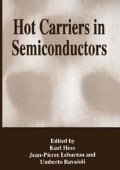Abstract
The requirements of high speed and performance and cost effectiveness demand of VLSI chips a continuing push in miniaturization. As a consequence, the design rule (or the effective gate length) has been reduced from several microns down to < 0.1 μm envisioned within a few years. While the expected 256 Mb chip requires the use of quarter micron design rules, it is expected that we will need 0.1–0.15 μm rules for gigabit chips, and the extrapolation of the down scaling trends will extend the design rules to sub-0.1 μm for a terabit memory chip in the near future. With this scenario for VLSI technology development, the deep understanding of the device physics governing device operation is the key to successful device design, as different physical mechanism impose different level of effects on different device scales.
Access this chapter
Tax calculation will be finalised at checkout
Purchases are for personal use only
Preview
Unable to display preview. Download preview PDF.
References
. D. K. Ferry, Y. Takagaki and J. R. Zhou, “Future ULSI: Transport Physics in Semiconductor Nanostructures,” Jpn. J. Appl. Phys.33: 873 (1994).
H.-S. Wong and Y. Taur, “Three-Dimensional ‘Atomistic’ Simulation of Discrete Random Dopant Distribution Effect in Sub-0.1μm MOSFET`s,” IEDM, p. 705, 1993.
J.-R. Zhou and D. K. Ferry, “Simulation of ultra-small GaAs MESFET using quantum moment equations,” IEEE Trans. Electron Devices39: 473 (1992).
J.-R. Zhou and D. K. Ferry, “3D Simulation of Deep-Submicron Devices: How Impurity Atoms Affect Conductance,” Comp. Sci. Engr.2 (2): 30 (1995).
E. Zaremba and H. C. Tso “Thomas-Fermi-Dirac-von Weizsacher hydrodynamics in parabolic wells,” Phys. Rev. B. 49: 8147 (1994).
F. Stern and S. Das Sarma, “Electron energy levels in GaAs-Ga1-xAlxAs heterojunctions,” Phys. Rev. B.30: 840 (1994).
Author information
Authors and Affiliations
Editor information
Editors and Affiliations
Rights and permissions
Copyright information
© 1996 Plenum Press, New York
About this chapter
Cite this chapter
Zhou, J.R., Ferry, D.K. (1996). 3D Discrete Dopant Effects on Small Semiconductor Device Physics. In: Hess, K., Leburton, JP., Ravaioli, U. (eds) Hot Carriers in Semiconductors. Springer, Boston, MA. https://doi.org/10.1007/978-1-4613-0401-2_112
Download citation
DOI: https://doi.org/10.1007/978-1-4613-0401-2_112
Publisher Name: Springer, Boston, MA
Print ISBN: 978-1-4613-8035-1
Online ISBN: 978-1-4613-0401-2
eBook Packages: Springer Book Archive

